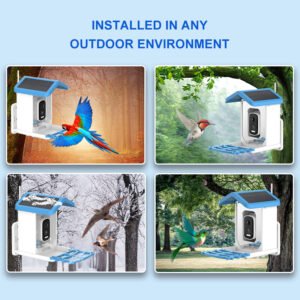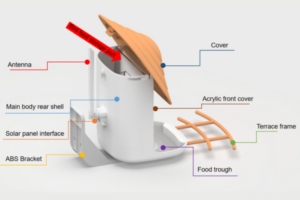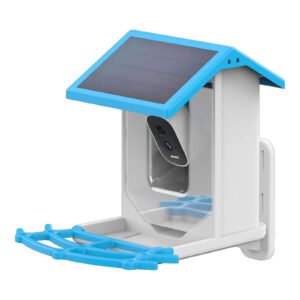If you’re wondering whether it’s safe to place your hummingbird feeder next to a regular bird feeder, you’re not alone. Many bird enthusiasts worry that placing these feeders too close together could cause conflicts or deter birds from visiting. However, the proper setup can ensure that both types of feeders attract birds without interference. In this article, we’ll explain whether hummingbird feeders can be placed near bird feeders and offer tips for a harmonious bird-watching environment.
Placing a hummingbird feeder next to a regular bird feeder can work well if done correctly. While some birds may be territorial, understanding bird behavior and positioning your feeders thoughtfully will help attract a variety of species without causing conflict. Read on for expert advice on how to set up your bird feeders properly.
Want to ensure that your bird feeders are attracting the right visitors? Keep reading for essential tips on feeder placement and setup!
Can Hummingbirds Smell Bird Feeders?
Hummingbirds primarily rely on their excellent vision rather than their sense of smell to locate feeders. They are attracted to bright colors, particularly red, which is why many hummingbird feeders are designed with red coloring or accents. Although their sense of smell is not as developed as other animals, hummingbirds can detect certain scents if they are potent enough. However, they are unlikely to use smell as their primary method for locating feeders. Instead, focus on the visual appeal of your feeders to attract hummingbirds.
Can You Put a Finch Feeder Close to a Hummingbird Feeder?
Yes, you can place a finch feeder close to a hummingbird feeder, but it’s important to consider the behavior of both species. While hummingbirds are territorial, finches tend to be less aggressive and are more likely to coexist peacefully with other bird species. However, to avoid competition for space, ensure that the feeders are positioned in a way that provides enough room for each bird to feed comfortably. You might also want to separate the feeders slightly if you notice any territorial behavior from the hummingbirds.
Where Not to Put a Hummingbird Feeder?
Certain areas should be avoided when hanging a hummingbird feeder to ensure both the safety of the birds and the feeder’s effectiveness. Avoid placing the feeder in areas that are heavily exposed to wind, as it can cause the nectar to spoil more quickly. Also, don’t hang the feeder in places where there is a lot of foot traffic or noise, as this can scare the hummingbirds away. It’s important to keep the feeder away from places where predators, such as cats, can easily access it, as they pose a threat to the birds.
Where Should You Not Hang a Hummingbird Feeder?
To provide the best environment for your hummingbirds, there are a few spots you should avoid when hanging a feeder. Don’t place the feeder in direct sunlight for long periods of time, as it can cause the nectar to ferment. Additionally, avoid hanging it near areas where there are a lot of insects, such as wasps, which may compete with the birds for nectar. Lastly, refrain from placing the feeder near large windows where birds might accidentally fly into the glass, as this can cause injury.
Can I Hang a Hummingbird Feeder in a Tree?
Yes, you can hang a hummingbird feeder in a tree, but there are a few things to keep in mind. Choose a tree that is not too dense or shaded, as hummingbirds prefer a spot where they can easily see the feeder and feel safe. Hanging the feeder in a tree also provides a natural setting for the birds and makes it easier for them to perch nearby when they are not feeding. Ensure that the tree branch is sturdy enough to hold the weight of the feeder and that it’s not too exposed to wind.
Can I Hang a Hummingbird Feeder on My Porch?
Hanging a hummingbird feeder on your porch is a great idea, as it allows you to enjoy bird watching from the comfort of your home. Just be sure to hang the feeder in a spot where it is not exposed to direct sunlight or high winds. You’ll want to place it in an area where hummingbirds feel safe and have access to cover, such as nearby plants or hanging baskets. Additionally, ensure that the feeder is placed at a comfortable height for both the birds and yourself.
How to Hang a Hummingbird Feeder from Eaves
Hanging a hummingbird feeder from the eaves of your home is a great option if you have limited space in your garden. To do this, use a sturdy hook or bracket that can hold the weight of the feeder. Make sure the feeder is not too close to the eaves to avoid blocking the birds’ access to the nectar. It’s also important to place the feeder in a spot where the birds feel safe, away from predators and high traffic areas. A hanging feeder near plants or flowers will create an inviting environment for the hummingbirds.
How to Hang a Hummingbird Feeder on a Balcony
If you live in an apartment or have a balcony, hanging a hummingbird feeder is still an option. Use a balcony hook or a suction cup mount to securely attach the feeder to the railing or wall. Ensure that the feeder is placed away from strong winds and is in a spot that offers shelter and visibility. Additionally, make sure that the nectar won’t spoil too quickly by avoiding direct sunlight. A shaded balcony area with nearby flowering plants will attract hummingbirds.
How Far Apart Should Hummingbird Feeders Be from Other Bird Feeders?
Hummingbird feeders should be placed at least 10 to 15 feet away from other bird feeders. This distance helps prevent territorial behavior and ensures that hummingbirds have their own space to feed without interference from larger birds, such as finches or woodpeckers. It also reduces the chance of competition for nectar and ensures that both the hummingbirds and other birds can feed peacefully. Keep in mind that hummingbirds are very territorial, so a little distance between the feeders will make them feel more secure.
When Do You Put Hummingbird Feeders Away?
Hummingbird feeders should be kept up year-round, especially in regions with mild climates, as hummingbirds may migrate to your area even in winter. However, if you live in an area where hummingbirds migrate during the colder months, it’s best to take the feeders down in late fall, around October or November. This prevents the feeder from attracting migrating birds too early, which could disrupt their natural migration patterns. In spring, you can put the feeder back up to welcome returning hummingbirds.
Conclusion
Placing a hummingbird feeder next to a regular bird feeder can work well if positioned correctly. By following these tips on feeder placement, you can create a harmonious environment where hummingbirds and other bird species can feed safely. Whether you’re hanging your feeders in a tree, on a balcony, or from the eaves, proper setup is key to attracting a wide variety of birds to your yard.






